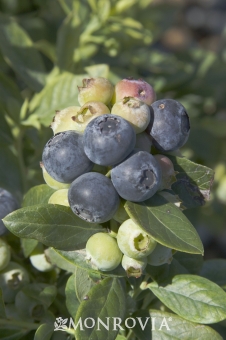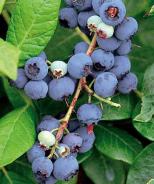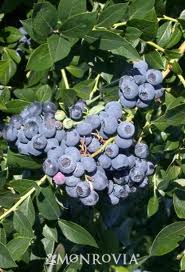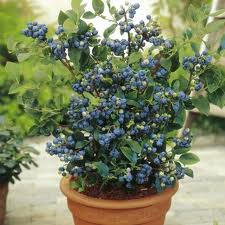|
Blueberries
 A
couple of years ago my wife, Margaret, decided that since I enjoyed
blueberries so much (and that they’re so good for you) we should grow them
in our garden. She brought home a couple of the traditional northern
deciduous type plants along with three evergreen “Sunshine Blue” hybrids
developed from southern varieties. I have to admit to being skeptical about
the whole project. Many years prior to this we had attempted to grow
blueberries with a huge 30-year-old plant we bought from a blueberry farm
going out of business. Among other things we learned why farmers usually
replace their plants after 15 to 20 years of production! Additionally, I
didn’t believe that an evergreen hybrid like this could produce a decent
crop of tasty berries and also function as a lovely ornamental plant all
winter long. A
couple of years ago my wife, Margaret, decided that since I enjoyed
blueberries so much (and that they’re so good for you) we should grow them
in our garden. She brought home a couple of the traditional northern
deciduous type plants along with three evergreen “Sunshine Blue” hybrids
developed from southern varieties. I have to admit to being skeptical about
the whole project. Many years prior to this we had attempted to grow
blueberries with a huge 30-year-old plant we bought from a blueberry farm
going out of business. Among other things we learned why farmers usually
replace their plants after 15 to 20 years of production! Additionally, I
didn’t believe that an evergreen hybrid like this could produce a decent
crop of tasty berries and also function as a lovely ornamental plant all
winter long.
For the first two seasons
I mostly ignored the new berry plants out of my skepticism and further
because it is recommended that you limit your harvests for the first one or
two years on young plants. Then early in the third summer Margaret told me
I better check out the new berries and that I might want to take a container
with me and pick some. When I finally got around to sampling the crop, I
found I needed to go back and get a second container to pick all the
wonderfully sweet berries that were ready for harvest.
During the course of the
summer I harvested at least 10 quarts of berries from those plants for
wonderful pancakes, waffles and pies. Only a handful came from the “normal”
highbush plants while the shorter “Sunshine Blue” produced nearly all the
crop. Admittedly the former plants were tucked behind the latter in a
shadier spot. But the Sunshine Blue’s yield and taste quality were both
great. And with the many reports continuing to come out regarding the
health aspects of eating blueberries I have become a proponent of the grow
your own blueberry movement.
It seems with each passing
year there is more information that links blueberry consumption with better
health. There is lots of evidence that eating blue fruit provides the body
with many compounds that slow down several things commonly associated with
the aging process: antioxidants to keep cell types from premature changes
associated with cancer and vascular diseases, resveratrol now thought to
also inhibit some of those same processes, compounds suggested to help
prevent some of the destructive mechanisms of the brain leading to
Alzheimer’s disease and, of course, lots of vitamin C in the fresh berries.
Origins
The common blueberries
found in most supermarkets are grown on Northern Highbush type plants.
These are commercially grown descendents of the lowbush varieties still
found growing in the wild throughout much of Northeastern North America.
Many of the “wild” blueberries sold today are picked from these lowbush
varieties in places like Maine, Quebec and Nova Scotia. The largest
commercial producers of berries are in Michigan with additional product
coming from the Pacific Northwest.
Southern varieties were
developed from native southern lowbush type plants and crosses with northern
plants. Some varieties are better in certain climate zones than others.
For example, the southern varieties are not cold tolerant and will not
survive the colder winters of the Northern North America. Likewise some of
the northern varities need a certain amount of cold and will not thrive in
warmer regions of the world. In moderate climates, such as the Pacific
Northwest, both types of blueberries do well and more attention can be paid
to taste and productivity than to survivability of a particular variety.
Since the size of the
mature plants can range from less than a foot to more than 12’ attention
should be paid to the planting space available. For small gardens, consider
a lowbush plant rather than one of the larger highbush varieties. While we
haven’t yet explored many other southern types, my own favorite is the
Sunshine Blue. It has a slightly tart but very flavorful taste and it
produces very well for us in Seattle over the course of the entire summer.
If the weather cooperates you might even be harvesting into October.
Requirements
Blueberries will produce
the most fruit when grown in full sun. Most will tolerate some shade but
the production will usually decline in direct proportion the amount of shade
the plant receives during the day. Ideally your berry plant will get at
least 7 - 8 hours of direct sun during midsummer. These plants are not
what we would call drought tolerant. They do need plenty of water during
the growing season. For those plants that produce a harvest early in the
summer, they will benefit from additional water during the late summer so
they do not go dormant until the cold weather arrives in the early fall.
This enables them to store up more energy for use the following year. You
can tell when they are going dormant by their leaf color. As the leaves
begin to shut down they start to change to varying shades of red and
orange. Once this starts to happen it is usually too late to stop so keep
those plants watered from harvest time until frost-time (if you are in a
frost forming region).
Additionally, blueberries
require a soil that is quite acidic. For those of us in the rainy Northwest
this is often our norm, but in other areas you may have to amend your soil
to achieve a good harvest. Several methods can help to lower your soil pH.
The goal is soil of a pH of 5 or less. Adding peat moss, fly ash, elemental
sulphur and using acid type fertilizers all will help.
Pruning is relatively
simple and should be carried out early in the spring. Remove dead and
broken branches. Remove no more than 20 to 25% of the branches, taking care
to cut out the oldest, largest canes. Leave the newest canes to produce the
fruit for the next several years.
Harvest the berries when
they are ripe to taste. Which means you’ll have to do a bit of taste
testing when the end of spring starts to roll around. Some varieties have
different looks at ripening than others so it is important to be familiar
with what your varieties look like when they are ripe. One of the varieties
I grow is not ripe until all signs of green are gone from the bottom of the
berry. The other varieties I have do not have this green spot on the bottom
of the fruit so that color method doesn’t work for them.
Relatively few problems
plague blueberry farming. One that many of us urban farmers seem to have is
competition form birds. In my own case, I believe there are two factors
working in my favor: 1.) The variety I primarily grow (Sunshine Blue) is
slightly on the tart side and think this helps make those particular fruits
somewhat less desirable to the birds and 2.) It appears we several
neighboring cats that seem to lurk beneath the berry bushes acting as guards
over our crop. There is bird netting that can be used but is a bit
troublesome to move each time you have to get to the plants. However, if
that is the only alternative it is better than giving much of your harvest
to the winged predators.
The following
information is from one of our suppliers, Monrovia Nursery:
Companion Plants
(Description): Blueberries work well with other acid
loving shrubs such as Normandy Rhododendron, (Rhododendron x
'Normandy'), Girard's Hot Shot Azalea, (Azalea x 'Girard's
Hot Shot'), Marge Miller Camellia, (Camellia sasanqua 'Marge
Miller'), and Blue Sapphire Ceanothus, (Ceanothus x 'Blue
Sapphire').
Design Styles:
Blueberries need not be limited to the confines of a kitchen
garden or orchard. Makes an attractive accent in shrub
borders as well with great seasonal changes. Ideal against
fences and foundations of outbuildings. Well suited to areas
around the acidic transitional edges of conifer canopy
driplines or openings in natural woodlands. Line them up for
a delicious and beautiful hedge for easy picking access.
Share fruit with birds by adding to habitat gardens.
Care Information
Provide an acidic, well-drained soil.
Water regularly during the growing season to maintain a
deep, extensive root system. Before new growth begins, prune
off twiggy growth, leaving only main stems to prevent
overbearing; feed with an acidic fertilizer.
Background Information
History: The
blueberries fit into the acid loving Ericaceae, with a genus
that includes 150 species of shrubs, most native to the
Northern Hemisphere with concentrations in North America and
eastern Asia. This variety is a hybrid of two native
species. V. corymbosum is native from Maine to Florida and
west to Louisiana. V. angustifolium is strictly a northern
plant fround in mountains from the Arctic south to Minnesota
and Virgina.
Lore:
Blueberries are the most popular native American fruit and
recent breeding has extended cultivation well beyond their
original range. They are among the fruits richest in
antioxidants and are eaten fresh, dried, baked and in jams.
Catalog Description:
Cold hardy and vigorous blueberry produces an
abundance of small dark blue fruit. Compact plants are
better suited to small gardens. Produces small white bell
shaped flower clusters in spring. Bright green leaves
brighten to orange in fall. Prefers acid soils pH 4.5 to
5.5. Deciduous. Full sun protected from wind and hot
afternoons in summer. Moderate growth 6 feet tall, 5 feet
wide.
Current Availablility
As of June 15, 2015: Bluecrop, Bountiful Blue, Chandler,
Darrow, Jersey, Liberty, Patriot, Spartan, Sunshine Blue and
Evergreen Huckleberry
Varieties
Northern Highbush
Performance and Requirements
Light needs:
Full sun
Watering Needs:
Needs regular watering - weekly, or more often in extreme
heat.
Growth Rate:
Moderate Growing
Growth Habit:
Multiple Trunk
-
Northland Blueberry
- Plant type:
Deciduous Shrubs
- Cold Hardiness Zone:
3-7
- Light needs:
Full sun
- Mature size:
Moderate growing to 6 feet tall and 5 feet
wide.
- Growth Habit:
Multiple Trunk
- Blooms:
Bell-shaped flowers in late spring.
|

Cold hardy and vigorous blueberry
produces an abundance of small dark blue fruit. Compact
plants are better suited to small gardens. Produces small
white bell shaped flower clusters in spring. Bright green
leaves brighten to orange in fall. Prefers acid soils pH 4.5
to 5.5. Deciduous. Full sun protected from wind and hot
afternoons in summer. Moderate growth 6 feet tall, 5 feet
wide.

-
Patriot Blueberry
- Plant type:
Deciduous Shrubs
- Cold Hardiness Zone:
3-7
- Light needs:
Full sun
- Mature size: 6
to 12 ft. tall, 8 to 12 feet wide.
- Growth Habit:
Arching
- Flower Color:
White
- Blooms:
Pink-tinged small white flowers in late
spring.
|
Enormous sweet berries cover this early
producer. Great looking plants bear attractive dark green
foliage brightening to scarlet and orange in fall. White
bell-shaped flowers bloom early spring. Shelter from wind
and hot sun. Prune to shape before spring bloom. Prefers
acid soils with a pH of 4.5 to 5.5. Deciduous. Full sun.
Moderate growth 6 to 12 ft. tall, 8 to 12 ft. wide.
Northsky Blueberry Half high dwarf blueberry, yields 1 to 3 lbs per plant per
season. Plant grows to 18" to 24" and spreads to 30".
Northblue Blueberry Dwarf blueberry yielding 3 to 4 lbs per plant. Reaches
2 to 3' in height.
Blueberry Performance and Requirements
Light needs:
Full sun
Watering Needs:
Needs regular watering - weekly, or more often in extreme
heat.
Growth Rate:
Moderate Growing
Growth Habit:
Arching
Care Information
Provide an acidic, well-drained soil.
Water regularly during the growing season to maintain a
deep, extensive root system. Before new growth begins, prune
off twiggy growth, leaving only main stems to prevent
overbearing; feed with an acidic fertilizer.
Southern Lowbush
Types: Sunshine Blue & Bountiful Blue
-
Sunshine Blue
- Plant type:
Deciduous Shrubs
- Cold Hardiness Zone:
5-10
- Light needs:
Full sun
- Mature size:
Semi-dwarf shrub 3 to 4 ft. tall and wide.
- Flower Color:
Pink
- Blooms: Pink
bell-shaped flowers late spring.
|

Hot pink bell shaped
flowers are decorative before fading to
white. Blooms in late spring. Yields an
abundant crop of large tangy fruit with
as few as 150 hours of chill. Self
pollinating, but produces best when
planted with another variety. Dwarf
stature is far more suited to ornamental
gardens and small space landscapes than
other varieties. Semi-evergreen shrub.
Full sun. Moderate growth 3 to 4 feet
tall and wide
Performance and Requirements
Light needs: Full sun
Watering Needs: Needs regular
watering - weekly, or more often in
extreme heat.
Care Information
Provide an acidic,
well-drained soil. Water regularly
during the growing season to maintain a
deep, extensive root system. Before new
growth begins, prune off twiggy growth,
leaving only main stems to prevent
overbearing; feed with an acidic
fertilizer.
|
Sunshine
Blue description from Weeks Berry Nursery (another
grower of our stock):
Midseason.
For gardens from San Diego to Seattle, Sunshine Blue has it
all. This semi-dwarf evergreen blueberry features a
highly-branched compact habit to 3 feet tall. The showy hot
pink flowers in spring yield large crops of dime-sized,
delicious blueberries with a unique tangy flavor for up to 9
weeks in the summer. Sunshine Blue tolerates higher pH soils
better than other blueberries. It is self pollinating. The
low chilling requirement of 150 hours makes it suitable for
Southern California, but we find it is surprisingly cold
hardy and a wonderful addition to our Northwest gardens.
Zones 5-10. |
|
Evergreen Huckleberry (Vaccinium
ovatum)
Native blueberry in the Pacific Northwest.
Blueberry Performance and Requirements
Light needs:
Full sun to shade but produces more fruit with more sun
exposure
Watering Needs:
Needs regular watering to establish, reasonably drought
tolerant, especially in the shade.
Growth Rate:
Moderate growing, average height 5 to 6' in sunny sites,
taller in shady spots
Growth Habit:
Arching, bushier in the full sun
Care Information
Provide an acidic, well-drained soil.
Water regularly during the growing season to maintain a
deep, extensive root system. Feed with an acidic fertilizer
to promote growth. Mulch well for better drought tolerance.
Questions about our trees and shrubs?
Email
Chuck! Looking for something in particular? We take special orders. Just call us! Don't know what you want? Just stop by and we can help!
|






